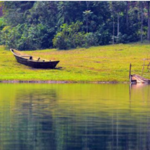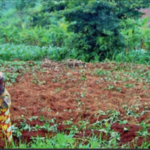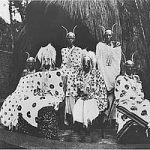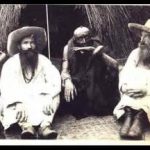Discovery And Early European Occupation
The plateau is quite isolated so that the Banyarwanda, the people of Ruanda, had little contact with the outside world. No European had explored Ruanda before the German Baron von Goetzen entered Ruanda through Gisaka in 1894. Gisaka was an ancient kingdom conquered by the Banyarwanda in the Nineteenth Century. It was composed of the three provinces of Mirenge, Gihunya, and Migongo. Henry M. Stanley had tried to enter it from Karagwe, Tanganyika, sometime before, by crossing the wide marshes bordering the Kagera River, but he was greeted with volleys of arrows from the Ruanda side before he could even reach the shore; he made no other attempt.
It was only in 1898 that the Germans finally established an outpost at the place where the city of Bujumbura is now situated. Although Bujumbura is in Burundi, it was established to control both kingdoms, then part of the German possessions in East Africa. The first Resident was Dr. Richard Kandt.
As early as 1900, White Fathers had established a Mission at Save near the present-day city of Butare, Ruanda.In 1901, they created another Mission at Zaza in the Territory of Kibungu, about eighteen kilometers from Remera as the crow flies.
In 1916, the Belgians entered Ruanda from the Congo and drove out the Germans. On 30 May 1919, Ruanda-Urundi was mandated by the League of Nations to Belgium through the Otis-Milner Agreement.
Not much was done by either nation to exploit Ruanda. Local government was largely left to native administration. Ruanda was and still is very much isolated from the rest of Africa and the test of the world. No colonization was contemplated by either German or Belgian administration because of the topography of the land and the shallowness of the topsoil — both of which are incompatible with modem farming methods. Mineral resources are few and far from the world markets so that, even today, only casserite is mined but not to such an extent that it ever was considered worth white to improve communications.
Only the Germans had contemplated systematically using Ruanda (and Burundi) as a labor reservoir for their colony in Tanganyika. Of course, Ruanda isa labor reservoir for Uganda and Tanganyika and, previously, the Congo, but recruiting was not systematized beyond a few attempts by the Union Minière of Katanga. The Germans went as far as to study plans for a railroad starting from Dar-es-Salaam and reaching Ruanda. Labor recruiting would have been done systematically, and the natives provided with free return transportation.This project never materialized, however, because World War I broke out before it could be carried out. The plans for a railroad showed that it would have passed through Gisaka and greatly affected Remera.Even today, freight must be routed exclusively through the port of Bujumbura (Burundi), on Lake Tanganyika.
THE PEOPLE
The Germans found in Ruanda a well-marked classsociety made up of: (1) an aristocratic ruling class, the Tutsi, a commoner class of agriculturalists, the Hutu, an outcast group of potters, the Twa, who although they speak the same language and are maintained by the society, are not considered by the natives as being really part of it. According to a recent survey,the proportion of each of these classes in Ruanda is as follows: Tutsi, 17.5%; Hutu, 81.35%; and Twa, .98%. The origin of the terms Tutsi and Hutu is obscure, but, in fact, “Tutsi” refers to a “noble”, as “Hutu” refers to a “commoner” and not to different “tribes”.
It has been said that the Tutsi are herders and that the Hutu are agriculturalists. The dichotomy is not as clear-cut as this statement implies. It must not be taken to mean that the Tutsi herd cattle while the Hutu do not. Moreover, the fact that theTutsi have as great an agricultural production as that of the peasant Hutu must be taken into consideration. The writer believes the term peasant best describes the Hutu agriculturalist. It suggests both a way of life and a status. He will accept Professor Eric R. Wolf’s definition of “peasant”. The peasant is an agricultural producer aiming at subsistence. He is part of a greater culture group. It might be noted also that even if Professor L. A. Pallers’ reservation be accepted, namely, that a peasant must have some “cultural” distinction from the upper-class, the agriculturalists of Remera are, in the majority, peasants. The distinction, as described by Fallers, is slight; the “essential” culture can be the same, but there may be traits peculiar to each group.
The generally accepted theory regarding the rise of the classes in Ruanda is based nearly exclusively on traditional history. It states that the original inhabitants of the country were the Twa, hunters and inhabitants of the, forest. These were displaced by Hutu agriculturalists who removed the forest as they encroached upon the lands of the Twa. Then, just over a thousand years ago, a group of pastoralists invaded the country imposing their rule upon the Hutu through their ability to govern and through the fact that they had cattle so avidly desired by the agriculturalists that the latter were willing to sell land and self to the newcomers in exchange for a cow.
But no matter how they first arose, the fact remains that the Banyarwanda became divided into sharply differentiated classes, within each of which there exist subdivisions of status and rank. Traditionally, status among the Tutsi depends largely, but not wholly, upon closeness to the Royal Family; not only kinship closeness, but also feudal closeness. Status depends also upon rank, i.e., an ascribed function in the hierarchy.
Although the social system tends to keep the poor Tutsi out of poverty, either by helping them out or by making them Hutu, there are many Tutsi of low rank and low status in every community. On the other hand, there are rich Hutu, who by dint of power and large family lineages, could oppose, or at least hold their own against, the encroachments and exploitations of the established Tutsi authority. In the past, such lineages, whose position could not be destroyed, were absorbed, and, although the newly rich generation was still regarded as Hutu, its sons could be “Tutsi-ized” and its grandsons would be considered as Tutsi.
https://uk.amateka.net/discovery-and-early-european-occupation/https://uk.amateka.net/wp-content/uploads/2021/03/colonial.pnghttps://uk.amateka.net/wp-content/uploads/2021/03/colonial-150x150.pngModel CitizenshipThe plateau is quite isolated so that the Banyarwanda, the people of Ruanda, had little contact with the outside world. No European had explored Ruanda before the German Baron von Goetzen entered Ruanda through Gisaka in 1894. Gisaka was an ancient kingdom conquered by the Banyarwanda in the Nineteenth...BarataBarata rpierre@ikaze.netAdministratorAMATEKA | HISTORY OF RWANDA




